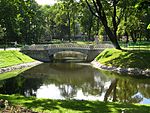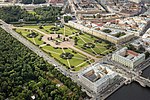Mikhailovsky Garden

The Mikhailovsky Garden (Russian: Михайловский сад) is a large area of parkland and landscape garden in the centre of Saint Petersburg. The garden was one of the early developments of the city soon after its foundation. Previously it had been part of the estates and hunting grounds of a Swedish noble, but after its capture during the region's conquest by the Russians in the early 1700s, it became part of the imperial estates, and was granted by Peter the Great to his wife Catherine for her palace. Catherine's palace, on the banks of the Moyka River, was known as the Golden Mansion, and the surrounding land was developed by Jean-Baptiste Alexandre Le Blond as a garden both for pleasure, and to provide supplies for the imperial household. During this time it went by several names, including the "Swedish Garden", the "Tsaritsyn Garden", and the "Third Summer Garden". The garden was further developed during the reigns of Empress Anna Ioannovna and Empress Elizabeth, who built new palaces and arranged the land to suit their own preferences. Empress Catherine's palace was demolished in 1768 and during the reign of Emperor Paul I the Mikhailovsky Castle was built to the east of the gardens. The garden was included in these redevelopments, but Paul was assassinated in the castle in 1801, and for some years after that the area was neglected. The next large scale redevelopment took place in the 1810s when Emperor Alexander I commissioned a new palace complex for his younger brother, Grand Duke Michael Pavlovich from architect Carlo Rossi. The Mikhailovsky Palace, named for its occupant, was completed in 1825 to the south of the garden, which was also substantially redeveloped as part of an ensemble that included the land to the north across the Field of Mars and as far as the Neva River. Assisted by Adam Menelaws, Rossi introduced the style and techniques of English landscape gardens, creating a large irregular oval meadow with alleyways, while the ponds were reshaped into more natural meandering outlines. Rossi also designed a pavilion and pier and a bridge as features for the garden. The garden served as the private grounds of the palace until its purchase for the state in 1898 and the establishment of the Russian Museum, at which point it became a city park. The garden survived the Soviet period, but suffered significant changes to its original composition. Children's play areas, tennis courts and public toilets were built on its grounds, while tree planting was carried out haphazardly, eventually blocking important sightlines around the ensemble. Transferred to the Russian Museum in 1999, the garden underwent substantial restoration in the early 2000s, which recreated Rossi's original designs. The garden was designated an "object of historical and cultural heritage of federal significance" in 2001, and since 2008 has hosted the annual International "Imperial Gardens of Russia" Festival.
Excerpt from the Wikipedia article Mikhailovsky Garden (License: CC BY-SA 3.0, Authors, Images).Mikhailovsky Garden
Moyka River Embankment, Saint Petersburg
Geographical coordinates (GPS) Address Nearby Places Show on map
Geographical coordinates (GPS)
| Latitude | Longitude |
|---|---|
| N 59.939722222222 ° | E 30.332777777778 ° |
Address
Дуб черешчатый
Moyka River Embankment
191041 Saint Petersburg (Palace District)
Saint Petersburg, Russia
Open on Google Maps











